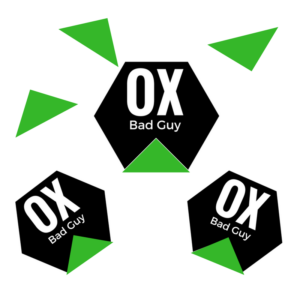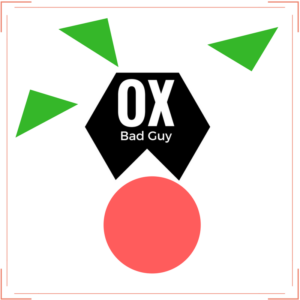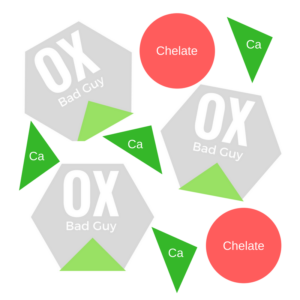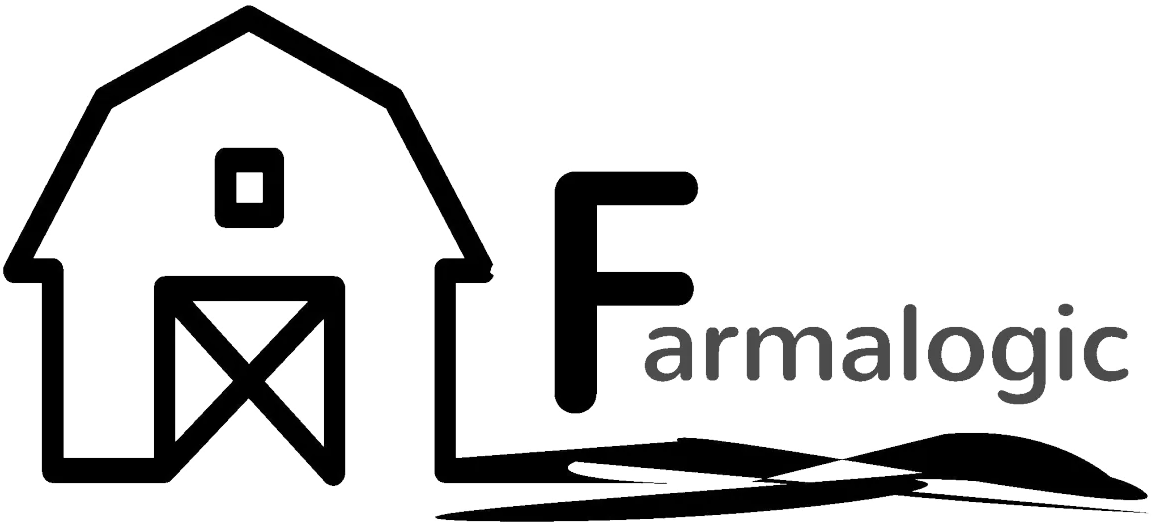Scientists have known since the early 1980s and probably at least a decade earlier that feeding supplementary dietary inorganic sources of calcium and phosphorous successfully controls equine nutritional secondary hyperparathyroidism (bighead disease) in horses grazing high oxalate pastures. Much of the published work was conducted by McKenzie and colleagues in Queensland, Australia.
 Oxalates are generally considered the bad guys of sub-tropical pastures, and for good reason. Let us go on an adventure into the gut of a horse to find out why. Please note that the illustrations used are to explain a concept and are not accurate at a molecular level. The large black shape represents the oxalate molecule and the green triangles represent the inorganic calcium molecules which bind together inside plants and in the horse’s gut.
Oxalates are generally considered the bad guys of sub-tropical pastures, and for good reason. Let us go on an adventure into the gut of a horse to find out why. Please note that the illustrations used are to explain a concept and are not accurate at a molecular level. The large black shape represents the oxalate molecule and the green triangles represent the inorganic calcium molecules which bind together inside plants and in the horse’s gut.
Oxalates act like magnets for calcium ions in the stew inside the gut. Calcium binds to oxalate molecules like spilt nails bind to a strong magnet. The calcium that is bound to the oxalate molecule continues on through the digestive tract to be passed in manure.
The calcium bound to the oxalate molecules is not bioavailable – it cannot pass through the gut wall and into the horse’s bloodstream to be transported to cells throughout the body. This means that horses grazing high oxalate pasture can become calcium deficient, even when they eat their daily recommended intake of calcium.
How much calcium does a horse need anyway?
A 500 kg horse in light work needs to consume 30 g of elemental calcium per day. A portion of this calcium requirement will be naturally contained in the roughage and hard feeds the horse consumes. Supplementary calcium is usually required to balance the diet and horses grazing high oxalate pasture need even more.
Mackenzie and colleagues demonstrated in 1980 that horses can safely graze high oxalate pastures if fed lots of extra calcium so enough remains in the gut to meet the horse’s needs after the oxalates had bound a full quota of calcium. Luckily for us, oxalates are not like little Pacmen with endless appetites!
 To bring it back to the nails analogy, if there are more nails spilt on the floor than the magnet can attract, then there will be nails left on the floor after the magnet passes over. By feeding extra inorganic calcium, Mackenzie ‘filled’ the oxalates with calcium and the left over calcium (represented as green triangles) was absorbed in high enough quantities to meet the horse’s requirements.
To bring it back to the nails analogy, if there are more nails spilt on the floor than the magnet can attract, then there will be nails left on the floor after the magnet passes over. By feeding extra inorganic calcium, Mackenzie ‘filled’ the oxalates with calcium and the left over calcium (represented as green triangles) was absorbed in high enough quantities to meet the horse’s requirements.
Mackenzie used calcium in the form of calcium carbonate and dicalcium phosphate to prevent and cure bighead. As long ago as 1906, a scientist called Lane successfully treated horses with severe symptoms in South Africa by feeding liberal amounts of legumes instead of oaten hay, and adding bonemeal to feeds and finely ground limestone added to drinking water. Veterinarian J. Barry David, DVM, published a refereed peer review in 1997 in Compendium Equine : continuing education for veterinarians where he recommended treating the condition with the use of legume forages such as lucerne and supplemental calcium carbonate to establish a whole of diet calcium to phosphorous ratio of at least 4 to 1 for a period of 6 to 12 months.
Inorganic calcium can be used to manage horses on high oxalate diets.
We have hard evidence then, that inorganic forms of calcium can prevent and treat bighead disease in horses by adding more calcium than the oxalates bind. But unless the horse has access to low oxalate (and preferably high calcium) alternative roughages and hard feeds, it can require a lot of calcium powder to leave the RDI for calcium in a high oxalate diet. At 34% elemental calcium, limestone (calcium carbonate) is one of the most concentrated sources of calcium available. Therefore our 500 kg horse needs to eat 88 g of limestone to consume the RDI of 30 g of elemental calcium if no other calcium is available from the diet.
 If the horse is eating 10 kg of high oxalate pasture containing 1.4% oxalates and only 0.3% calcium, the diet is also providing 140 g of oxalate and 30 g of calcium. The 140 g of oxalate can be expected to bind 70 g of calcium making it unavailable to the horse. Unless we supplement this horse with calcium, it will be mining 40 g of calcium from body stores (mainly bones) to maintain the necessary blood calcium levels. We can correct this balance by providing the horse with 40 g of calcium (to ‘feed’ the oxalates) plus 30 g of calcium (to meet the horse’s RDI). This is going to take 200 g of limestone, or 150 g of limestone plus 5 kg of lucerne hay (with 1 % calcium) to provide the other 50 g of calcium.
If the horse is eating 10 kg of high oxalate pasture containing 1.4% oxalates and only 0.3% calcium, the diet is also providing 140 g of oxalate and 30 g of calcium. The 140 g of oxalate can be expected to bind 70 g of calcium making it unavailable to the horse. Unless we supplement this horse with calcium, it will be mining 40 g of calcium from body stores (mainly bones) to maintain the necessary blood calcium levels. We can correct this balance by providing the horse with 40 g of calcium (to ‘feed’ the oxalates) plus 30 g of calcium (to meet the horse’s RDI). This is going to take 200 g of limestone, or 150 g of limestone plus 5 kg of lucerne hay (with 1 % calcium) to provide the other 50 g of calcium.
What about chelated calcium?
There is a popular theory that chelated forms of calcium in the form of calcium proteinates are more bioavailable because they do not bind to oxalates.
 To date no independent scientific evidence demonstrating this theory in horses has been published but the theory has merit.
To date no independent scientific evidence demonstrating this theory in horses has been published but the theory has merit.
If we decided to use chelated calcium to provide the 30 g of calcium to meet the RDI, we would have to add 150 g of a proteinate containing 20% calcium.
The first problem with this is the risk that free oxalates not bound to inorganic calcium could pass through the gut wall, where they can bind calcium ions in the blood and cause kidney damage.
The second problem is that chelated calcium proteinates are manufactured molecules and they are expensive, costing a few dollars per day to provide adequate calcium compared to the few cents per day that inorganic calcium supplements cost. This surprises many people who believe that ‘organic’ chelated minerals are natural when in fact they are manufactured in a factory and it is the inorganic minerals that are naturally occurring since they come from the ground!
The third problem is that the metabolism and delivery of chelated minerals is not well understood in horses, leading scientists to recommend an upper limit of 30% chelated minerals in a supplement (Ewing, 2003).
 The most common solution used by the nutritionists who design oxalate countering supplements for horses is to combine a mixture of inorganic and chelated (organic) calcium into a blend. This allows some inorganic and some chelated calcium to be absorbed. It also makes the product biologically effective as well as affordable.
The most common solution used by the nutritionists who design oxalate countering supplements for horses is to combine a mixture of inorganic and chelated (organic) calcium into a blend. This allows some inorganic and some chelated calcium to be absorbed. It also makes the product biologically effective as well as affordable.
Equine Vit&Min TropiCAL Blend provides all the minerals often missing from the diet including extra calcium for horses grazing high oxalate tropical pastures. Unlike other brands of oxalate countering products where customers need to be add a vitamin and mineral supplement and extra salt, with TropiCAL, all the extras are included. TropiCAL contains a blend of organic and inorganic minerals with added salt, biotin and Vitamin E. Find out more about EVM TropiCAL here.
What about Absorption? Are organic/chelated minerals 100% absorbed?
The recommended daily intake (RDI) of minerals have been calculated based on the levels of inorganic minerals required adjusted by absorption levels. So when the NRC (2007) says that a horse needs 30 g of elemental calcium per day, it means that the diet must provide 30 g of elemental calcium so that the horse can uptake a fraction of that to meet it’s daily needs. For calcium the NRC allows an absorption efficiency of 50% based on research findings, although some studies have shown that 70% can be absorbed. In 2005, Highfill and colleagues published a paper in the Proceedings of the 19th Equine Science Society demonstrating that a calcium amino acid proteinate was not absorbed any more efficiently than calcium carbonate.
The fraction that is absorbed is different for different mineral forms and also depends on the balance of other minerals such as phosphorous and magnesium in the gut. The actual amount of calcium absorbed at any point in time is strictly regulated by the body’s hormone parathyroid hormone (PTH). However Highfill’s findings (2005) indicate that PTH may still be able to regulate calcium uptake when in the form of an amino-acid proteinate.





Your Article on “Oxalates, Calcium & Your Horse” No Illustrations are shown
Thanks
Len
Thanks for picking that up Len – the images were lost in the transition to the new website. These have been added back in now. 😊
Thanks Foolproof! We will continue to discuss this issue wherever and whenever the opportunity arises! It is often covered in our nutrition lectures in high oxalate areas, on Facebook and we have had articles published in horse magazines but agree with you that it needs ongoing attention.